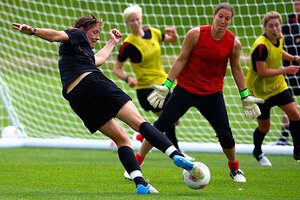Olympic soccer: Are US women facing the future in France?
The US women will open their Olympic soccer tournament against France Wednesday. In some ways, they will be seeking to emulate the technical skills of their opponents.

Abby Wambach from the US women's Olympic soccer team takes a shot at goal during a training session ahead of the London 2012 Olympic Games in Glasgow, Scotland, last week.
David Moir/Reuters
London
No matter what happens Wednesday, when the US women's soccer team opens its Olympic tournament against France, it has – in some ways – already lost.
To understand why, one need only look at the roster sheets.
Two words dominate the French roster: Olympique Lyonnais. It is the name of the top team in France's professional women's soccer league – a juggernaut side that has contributed 11 players to the French national squad and, in doing so, has helped propel the French women from perpetual also-rans to rising stars of the world stage.
On the US roster, three words are just as prevalent but far more worrisome: NO CLUB AFFILIATION.
This May, America's latest attempt to establish a professional league for women – Women's Professional Soccer (WPS) – folded. That three-year experiment followed another failed three-year experiment – the Women's United Soccer Association (WUSA) – which lasted from 2000 to 2003.
Now, the pressure is on, and America's Olympic dominance in the sport could be at stake.
From that moment in 1999 when Brandi Chastain's primal scream announced America as queens of the soccer world, the American women have seen their dominance slowly ebb. Back then, the Chastains and Mia Hamms and Julie Foudys were the product of the world's best talent pipeline for women's soccer: the US university system. During the past decade, however, the rest of the world has been playing catch-up.
First, Germany won the 2003 and 2007 World Cups, then Japan defeated the US in the 2011 final. In 2003 and 2007, in particular, the verdict was undeniable. The Americans were immensely talented, supremely fit, and driven by an unmatched desire to win. But they were being outplayed. The Germans could pass the ball more inventively, were more aware tactically, and their technical ball-handling skills in tight areas were a revelation.
In short, they were better – and that rise corresponded directly to the maturation and improvement of the German professional league founded in 1990.
Now, other teams are beginning to follow that same arc, building success by honing better, more technical players in nascent national leagues – Japan in winning in 2011, and France in announcing itself as the the team of the future the same year.
It leaves US women's soccer at a crossroads.
For the national team, the development of a women's league "is pretty critical," says Tony DiCicco, coach of that 1999 World Cup-winning side and the commissioner of the WUSA. "For us to expect that every college graduate is going to be fully developed is unrealistic."
Even in their short existence, the WUSA and WPS proved their worth to the US soccer cause. The US national team might not ever have seen Abby Wambach without it. Now she is now the No. 2 career goal scorer in US and world history, behind Hamm.
Having come from an unheralded soccer program at the University of Florida, she was not considered a top prospect for the US women's team. Had the WUSA not existed, she might have been one of those players sentenced to end their soccer careers at graduation, DiCicco says.
What is less clear, though, is how to make women's professional soccer prove its worth economically. Overseas, profitable men's soccer clubs have begun women's teams. The Olympique Lyonnais men's team, for example, is a fixture in Ligue 1 and won seven consecutive titles starting in 2002. In England, many of the best British women play for Arsenal, companion club to the legendary men's team.
But that model might have severe limitations in the US. Major League Soccer, while now firmly established, is not yet in a position to invest millions of dollars in the women's game. And the WUSA and WPS have shown that ambitious models for an independent top women's league were not viable.
DiCicco suggests starting small. Even after the fall of the WUSA and WPS, one professional and one semipro women's soccer league remain in the US – the Women's Professional Soccer League–Elite and the W-League. For players accustomed to the exposure and salaries of the WPS or overseas leagues, these might be a bit of a come down. But just as Germany did in 1990, America might need to build its club success slowly and organically.
"Build on that model – just get a few more top players involved," says DiCicco, speaking of the WPSL. "That may be close to being sustainable."
In some ways, the US women are already used to a dose of humility. On the world stage, they are the ones now playing catch-up. While they remain a favorite for gold in London, their push now is to "layer in sophistication to our game that wasn't there six to eight years ago," said national team midfielder Heather O'Reilly at a pre-Olympics media summit. "The game is becoming a little bit more cerebral and technical."
In advance of London, O'Reilly said, coach Pia Sundhage has "integrated some European flair into our attack."
On Wednesday, some of that European flair, honed on the training fields of Olympique Lyonnais, will be staring back across the field at them.

